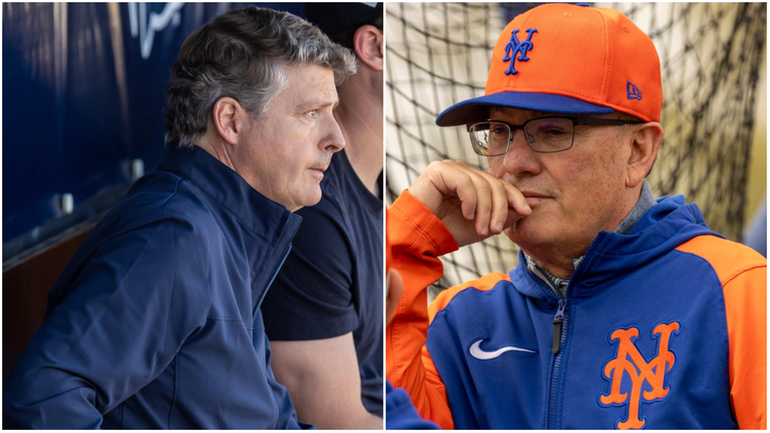To some extent, Yankees and Mets kept their wallets in their pockets this time around

Yankees owner Hal Steinbrenner, left, and Mets owner Steve Cohen.
The most shocking thing about Shohei Ohtani signing a $700 million contract with the Dodgers wasn’t necessarily the money.
For the two-way baseball unicorn, available as a free agent for the first and last time of his likely Hall of Fame career, the safe bet was to take the over. And then tack on another $100 million.
No, around here, the real stunner was having the Yankees’ Hal Steinbrenner and the Mets’ Steve Cohen watching from the sidelines, their sizable wallets remaining holstered as the Dodgers locked up baseball’s 21st century Babe Ruth.
It wasn’t a matter of need. Even with Ohtani limited to DH duties this season coming off elbow surgery, who wouldn’t want a global superstar with peerless marketing reach (illegal gambling controversy aside) -- a one-man revenue stream the size of Niagara Falls.
Turns out, even billionaires have budgets. And what we learned this winter is that many teams, including the Yankees and Mets, looked more closely at the price tags during this salary cycle.
There were the Dodgers, who invested $1.162 billion in three players in the offseason -- Ohtani, Japanese ace Yoshinobu Yamamoto ($325 million), Rays import Tyler Glasnow ($137 million) -- and then there was everyone else. It’s not as if the Lords of Chavez Ravine didn’t telegraph their spending frenzy, either. Just check the list of 2023 payrolls and you’ll see that the Dodgers ranked sixth overall, at a paltry $240 million, more than $100 million less than Cohen’s Mets.
This SoCal perfect storm was brewing for months, if not longer. While the Yankees and Mets were tied up at the top tiers of the competitive balance tax (CBT) thresholds, the Dodgers waited with their winter war chest. For the rest of baseball, it was a wipeout.
“This has been a monumental offseason for all of us,” Dodgers manager Dave Roberts said at Yamamoto’s introductory news conference.
Count the Dodgers as the latest franchise to try to buy a championship, on the heels of Cohen’s failed efforts the previous two seasons, and the Steinbrenners playing checkbook baseball over five decades in the Bronx. It’s not that the Yankees and Mets built rosters on the cheap for 2024. Cohen still has the sport’s highest payroll at $328 million (for luxury tax purposes) and Steinbrenner is third at $308 million, so they’re ponying up the cash.
The difference this winter? Cohen and Steinbrenner took their $300 million swings at Yamamoto, then (mostly) bowed out of the ring for the remainder of the offseason, rather than be market-makers for the next tier of free agents -- the crop of very good players, but not viewed as generational stars. And simply because the Yankees and Mets were willing to spend $300 million on Yamamoto -- way above his initial projected value -- that didn’t mean the unspent cash was burning a hole in their respective pockets.
Hal was content with the December trade for Juan Soto (cost: $31.5M) and the $37 million pivot to Marcus Stroman after missing out on Yamamoto. Cohen spread around roughy $72 million on free agents, but is still on the hook for another $50 million this season for players on other teams: Max Scherzer, Justin Verlander and James McCann. Once you take these factors into account, and already bloated payrolls, it’s understandable why the Bronx and Flushing were mostly closed for business once the teams headed south for spring training, aside from the Mets signing J.D. Martinez to a one-year, $12 million contract a week before Opening Day.
“In the end, you try to decide what’s best for the team,” Cohen said when asked about the Dodgers’ sky-high investment. “What the payroll is at that time and what you’re going to commit over a longer period of time. If you’re going to commit those dollars, you better be pretty sure that these are special players.”
Ohtani certainly qualifies, and Yamamoto came with that reputation despite never throwing a pitch in the majors. (When he did throw his first pitches, the Padres teed off on them in last week's opener in South Korea.) As for who wasn’t considered “special?” At least for this winter, that group included the reigning National League Cy Young Award winner (Blake Snell), a former MVP (Cody Bellinger), a Gold Glove third baseman (Matt Chapman), a 33-homer DH (J.D. Martinez) and a sturdy lefty starter with a World Series ring (Jordan Montgomery).
The Mets certainly could have used any combination of those players, but ultimately settled late on Martinez at a bargain price to fill their long-time hole at DH (deferring all but $4.5 million of the contract). And as badly as the Yankees needed rotation help at the start of spring training, it got much worse when Gerrit Cole developed an elbow issue that is likely to cost him the first two months of the season. But Cohen and Steinbrenner both held their ground, as did most of the league, with Snell (2 yrs, $62M), Bellinger (3 yrs, $80M) and Chapman (3 yrs, $54M) all taking shorter-term deals loaded with opt-outs, a Scott Boras special when the market cools to his clients, for whatever reason.
Cohen has been signaling a pullback in his spending since last season’s trade deadline. And considering that his record-breaking payrolls cratered on the field, it’s no secret why he’s chosen a different direction under new president of baseball operations David Stearns.
Steinbrenner, however, doesn’t get to play that card. He pledged significant changes after last season’s 82-80 “embarrassment,” and some would argue that the Yankees’ managing general partner didn’t go far enough this winter. There were more upgrades available. The Yankees just chose not to go that route, and the luxury tax played a meaningful role in that decision-making process.
“Given where we are payroll-wise,” Steinbrenner said last month, “any addition to the club is going to be a costly one.”
Steinbrenner also said then that he’d be willing to consider anything general manager Brian Cashman brought to him and that the Yankees weren’t done trying to improve the roster. But since those remarks, it’s been status quo in Tampa, with the Yankees seemingly reluctant to dive back into the free-agent market even though the prices dropped to some degree (and impact players lingered on the market).
From a financial standpoint, whatever drag there was on free-agent salaries, most notably for Boras clients, was in no small part due to Steinbrenner and Cohen largely being spectators. Both are market drivers, but they took a back seat this winter. How that works out for them on this Opening Day and beyond will deliver the verdict on whether it was the right strategy.

